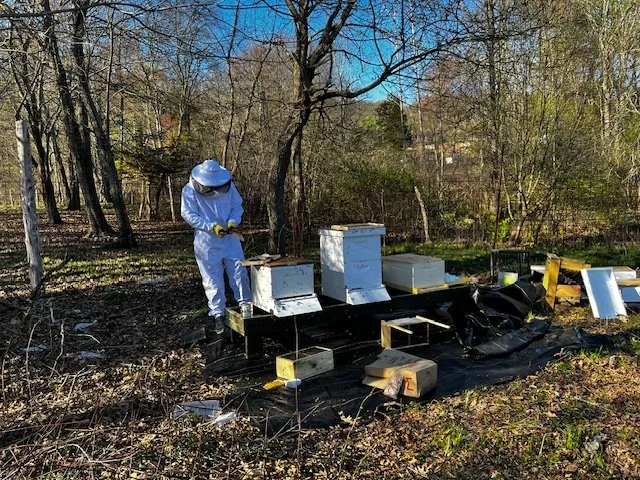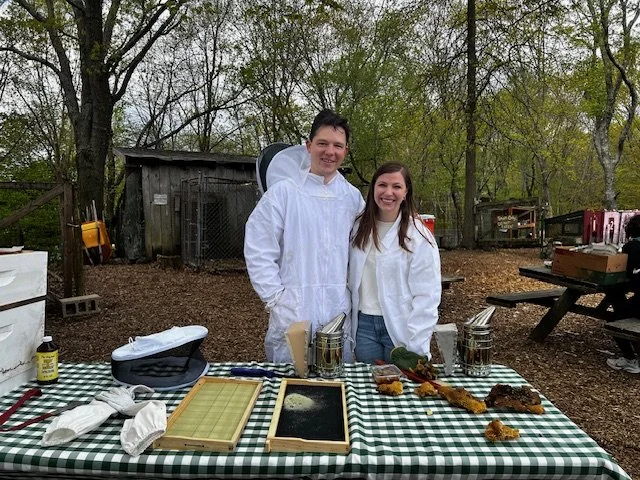Natick Organic Community Farms
The First Season: Starting the Community Hive Project at Natick Organic Community Farm
Beekeeping began as a curiosity—a way to reconnect with nature in a meaningful and hands-on way. At the time, I was working as a data scientist at a non-profit hospital, but I found myself diving deep into books and articles about pollination, food accessibility, and sustainable agriculture. I quickly realized how interconnected these sectors are, and it sparked a desire to use my analytical skills to explore how pollination could be tracked and optimized.
Knowing little about hive management, I enrolled in a beekeeping course with the Essex County Beekeepers Association. The hands-on lessons and conversations with seasoned beekeepers illuminated the intricate art and science of hive management. At the same time, I began imagining how I could combine honey bee installations with data-driven insights to support local food systems. Whether it would remain a personal project or evolve into a service to benefit others, I decided to call it The Community Hive Project.
I’ve always learned best by doing. Surprisingly, I found parallels between writing code at my day job and moving heavy bee boxes in a sunny field. Both involve iterative processes where small tweaks can unlock major improvements. Testing, measuring, and refining are essential, and progress often takes unexpected leaps. Unlike coding, however, beekeeping offers the benefit of physical work and being immersed in nature—a nice change of pace from “going to workout” after work.
By late February, I felt ready to put my ideas into practice. I reached out to farms in neighboring towns about setting up beehives, leaving voicemails and hoping for just one callback. After a month, I heard from Haley Goulet, Livestock Manager at the Natick Community Organic Farm, who said my timing was perfect. Over a picnic table in front of their greenhouse, she explained that their previous beekeeper had moved to Florida, leaving behind two hives. I offered to take over, free of charge, for the chance to manage live bees in public. Contributing to their mission of growing fresh, organic produce for the community made the opportunity even more meaningful.
Things began to come full circle. Haley and I coordinated a site visit with Kathy Balestriar, president of the Essex County Beekeepers Association, who confirmed the location was ideal, with plenty of sunshine, floral resources, and water for the bees. The existing hives, however, were struggling—a baseball-sized cluster of bees had barely survived the winter.
Gabe installing bee packages into three hives.
In early April, I installed three bee packages from The Colony in Tyngsborough, MA, reinforcing the two existing hives and adding a third hive. I “pinched” (sadly, killed) the existing two queens to bring in newer, healthier ones for optimal breeding.
Queen bee laying eggs, marked green for years ending “4” or “9”. This a new ‘24 queen.
Bee packages contain one queen and approximately 20,000 honey bees. I didn’t test for an allergy beforehand (as such tests aren’t always reliable for true reactivity), but as I was introducing the bees into their hive, I inevitably got stung twice, about 1 second apart. I felt a brief, five-second “flushed” sensation, and the stings became slightly itchy welt after six hours. By 60 hours, the welts had completely disappeared. My “self-exposure” experiment confirmed that I won’t be severely allergic—just a little slowed down.
Research highlights the benefits of bee stings, which contain compounds like melittin and adolapin with anti-inflammatory and antimicrobial properties. Some studies even suggest potential cancer-fighting benefits and allergen immunity passed from beekeepers to their children—a topic I plan to explore in a future post.
The western honey bee (Apis mellifera) often faces criticism for not being native to the U.S., but it been bred and managed here for over 300 years. The decline of native pollinators is less about competition with honey bees and more about habitat loss, pesticides, and herbicides. Honey bees pollinate 30% of the food we eat and contribute $12 billion annually to American agriculture.
Watching my bees forage on clover and herbs in early spring was fascinating as they instinctively adapted to their new environment. I began documenting their progress weekly—tracking flight paths, pollen colors, brood development, queen laying strength, and overall population. Their consistent work and the farm’s sustainable practices, free of pesticides, helped the hives thrive. By June, the bee population had grown from 20,000 to over 60,000 per hive. Pollination efficiency increased exponentially, seemingly enhanced by natural interactions with wild bees.
In May, we participated in Farm Fest at Natick Community Organic Farm, where my wife, Kaylee, and I set up a table with beekeeping tools and equipment. Visitors asked questions about bee lifespans and pollinator-friendly plants, inspiring me to create a booklet on the best flowers, herbs, and shrubs for supporting both honey bees and native pollinators.
It was such a wonderful experience connecting with my neighbors and answering their questions to the best of my abilities. The kids lit up as we explained how baby worker bees emerged from the comb after being incubated for 3 weeks. One particular conversation we had came from someone whose husband loved bees but was allergic: “We would love to have a beehive in our backyard, but we couldn’t take care of them” That moment sparked me to consider a future system where we could bring bees to people’s backyards and manage them on their behalf.
Gabe Verzino and his wife, Kaylee.
By mid June, the frames were filled top to bottom with beautiful brood (see picture below, progression is May 1, May 20, June 15). I estimated what began as roughly 20,000 from the bees packages increased to about 60,000 by June. Research suggests pollination efficiency doesn’t increase linearly with more bees—it’s exponential due to their networked coordination. I also noticed some mild competition between wild bees and honey bees. The presence of wild bees on flora seemed to enhance the pollination efficiency by honey bees. It’s as if they saw the flower was occupied, so would spring elsewhere, more rapidly transferring pollen between plants. My observation seems to be supported by the literature as well.
By late summer, we faced challenges—a nectar dearth slowed hive production, and one hive swarmed. I added honey supers (overflow of nectar into built comb with queen separation so she doesn’t lay eggs in those combs) but by then it was too late for the bees to build out. I continued to monitor their progress, but it was much slowed at this point in the season.
In early autumn, I treated the hives for varroa mites and set traps for hive beetles. The beetles clearly irritated the bees, but like a typical bee, they did their best to work around them. I prepared the remaining two hives for winter, removed top honey supers (e.g., boxes) that went unused, added sugar blocks, and covered them in a hive wrap to protect from cold.
Looking ahead, I plan to start next season with nucs (nucleus colonies) in early spring for a head start on production and relocate hives for better access to resources so they don’t get trapped in the greenhouse on flight paths.
Starting The Community Hive Project at Natick Community Organic Farm has been an unforgettable experience. Working with bees has shown me the value of taking small, calculated risks for the greater good. These tiny creatures have inspired me to do the same—learn, adapt, and grow with purpose.
Gabe and Ken Davis, business advisor from Galion, Ohio.





